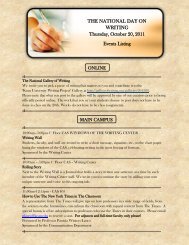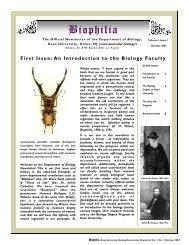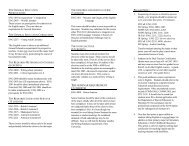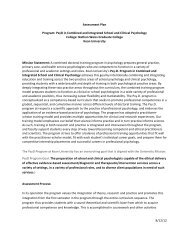GeorGe SeGal - Kean University
GeorGe SeGal - Kean University
GeorGe SeGal - Kean University
You also want an ePaper? Increase the reach of your titles
YUMPU automatically turns print PDFs into web optimized ePapers that Google loves.
4<br />
More famously, his commissioned double portrait of Pop Art collectors robert and Ethel Scull<br />
(1965), much to her dismay, captured and still holds one of Ethel’s expensive courreges boots.<br />
Segal returned to the self-portrait both overtly and covertly several times. In 1968, the work<br />
shown on the cover of Art News was titled Self-Portrait; showing the plaster simulacrum of the<br />
artist holding a plaster head, standing behind a seated, headless, plaster woman. Another<br />
example of the self-portrait, but not labeled as such inside the magazine, is Artist in Studio,<br />
showing the artist at work drawing two plaster figures deployed on a plaster mattress, two walls<br />
covered with pastels of nudes.<br />
II: When Does a Depiction Become a Portrait?<br />
the American modernist painter charles Demuth sometimes painted objects, letters, and<br />
numbers as stand-ins for faces. For instance, the number five in his “portrait” of William carlos<br />
Williams refers to Williams’ poem that begins “I saw the number five.” A particular person can<br />
be represented by particular things. robert rauschenberg, the Proto-Pop pioneer, famously sent<br />
a telegram to a French art dealer who had requested a portrait, saying “this is a portrait of Iris<br />
clert if I say it is.”<br />
At the opposite end of the portrait spectrum we have nearly photo-realistic depictions done<br />
by thomas Eakins in the 19th century, where, if we could travel back in time, we imagine we<br />
could exactly match the person to the painting, one subject and no other. the best portraits,<br />
of course, are about more than physical likeness; we like to see character and psychology.<br />
Was the subject generous, brave, and kind? Was he or she proud or humble, diffident or difficult?<br />
It should be noted, however, that rarely does the portrait, traditionally paid for by the subject,<br />
show unflattering traits. All blemishes of both face and character must go. Portrait-painters of a<br />
more unfettered eye and hand, such as the late Alice neel, gained few commissions and focused<br />
on family members and Bohemian friends who were less likely to rebel against her painterly<br />
“soul-catching.” And although neel sometimes thought of her victims as types, deemed a banker<br />
or a student or a pregnant woman, they were also specific people. the young man she always<br />
referred to as the wolf-boy, for instance, was the soon-to-be-prominent artist robert Smithson.<br />
How then are we to categorize Segal’s plaster sculptures? Assuming that the artist in all cases<br />
has provided his own titles, we might use these as clues. If the word “portrait” and/or the full<br />
name of the model is used in the title, then there can be no doubt that a portrait of a specific<br />
person was intended. Examples would be Segal’s first commission Man Leaning on a Car Door<br />
(robert Scull), 1963; Richard Bellamy Seated, 1964; John Chamberlain Working, 1965-67; Vera<br />
List, 1965; Man in A Chair (Helment von Erffa), 1969; and Portrait: Plaster Figure of Sidney Janis

















